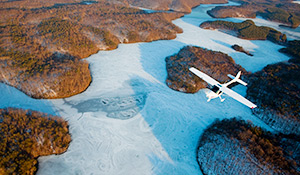 Brrrr! Winter has much of our country in its frigid grip, bringing with it the challenges of cold-weather flying. If you don’t have a hangar, preflighting the aircraft may be far more time-consuming than in the other three seasons as you face defrosting the airframe, preheating the engine, and shivering through the preflight checklist. When I was doing flight training, I remember spending several predawn winter mornings rubbing frost off the wings in biting wind and finger-numbing temperatures until my flight instructor had mercy and suggested we turn the airplane to face the rising sun and go inside for a cup of coffee. In an hour or so, both of us and the airframe were defrosted and able to take to the sky! On other occasions, there was room in the FBO’s hangar to pull the aircraft in and let the frost melt, which was my favorite option! Once sheltered, I regained enthusiasm for a leisurely and thorough preflight, which included drying off the dripping airframe so it didn’t refreeze when we moved it back outside.
Brrrr! Winter has much of our country in its frigid grip, bringing with it the challenges of cold-weather flying. If you don’t have a hangar, preflighting the aircraft may be far more time-consuming than in the other three seasons as you face defrosting the airframe, preheating the engine, and shivering through the preflight checklist. When I was doing flight training, I remember spending several predawn winter mornings rubbing frost off the wings in biting wind and finger-numbing temperatures until my flight instructor had mercy and suggested we turn the airplane to face the rising sun and go inside for a cup of coffee. In an hour or so, both of us and the airframe were defrosted and able to take to the sky! On other occasions, there was room in the FBO’s hangar to pull the aircraft in and let the frost melt, which was my favorite option! Once sheltered, I regained enthusiasm for a leisurely and thorough preflight, which included drying off the dripping airframe so it didn’t refreeze when we moved it back outside.
Once you’re in the airplane and have started the engine, plan to stay put for awhile. The engine needs to warm up, and it’s important to be patient while the oil temperature moves into the green. No cheating—leave the cowl flaps open—the air needs to flow over the cylinders while on the ground. Otherwise, you’ll cook the cylinder heads.
If there’s snow or ice on the taxiways, be very gentle on the brakes—and use them as sparingly as possible. Taxi slowly and if you’re flying a low-wing aircraft, watch the height of the snow piles on the edges of the taxiways. Know what the braking action reports are for the airport and call ahead to your destination to find out what the conditions are there. And remember to check notams.
When you get your weather briefing, file a flight plan. It’s great insurance—if you had to put the aircraft down in an emergency, you wouldn’t want to linger in the cold any longer than necessary. Consider throwing in some extra winter gear—gloves, hats, socks, boots, and even a wool blanket if the temperatures are cold enough to warrant them.
And speaking of weather, be familiar with the winter NOTAM contractions in the Aeronautical Information Manual’s NOTAM Contraction Table (Chapter 5-1-3) such as PSR (packed snow on runway), SLR (slush on runway), or LSR (loose snow on runway). If you find yourself close to the edge of the runway or taxiway, watch out for SNBNK (snowbank caused by plowing). And keep an eye on the NOTAMs for braking advisories: BRAG, BRAF, BRAP, or BRAN tell you whether the braking action is Good, Fair, Poor, or Nil.
Winter weather moves fast, so if the weather is different than forecast, consider filing a pilot report. Pireps can be given to the nearest flight service station, Flight Watch on 122.0, or through ATC. Report who you are, where you are, what time it is, and what the condition(s) are. Conditions can include flight visibility, temperature, wind speed and direction, turbulence, icing, cloud coverage and altitude, or precipitation.
And, after all the work to get airborne—enjoy it! Some of the most beautiful flights happen in winter, gliding through a brilliant blue sky over an untouched snowy landscape.
For more information on Winter Flying, read AOPA’s subject report and check out Air Safety Institute’s Webinar on cold-weather operations on AOPA Live®.



